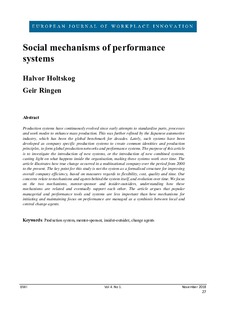| dc.contributor.author | Holtskog, Halvor | |
| dc.contributor.author | Ringen, Geir | |
| dc.date.accessioned | 2019-02-19T14:09:36Z | |
| dc.date.available | 2019-02-19T14:09:36Z | |
| dc.date.created | 2019-01-23T09:29:39Z | |
| dc.date.issued | 2018 | |
| dc.identifier.citation | European Journal of Workplace Innovation. 2018, 4 (1), 27-43. | nb_NO |
| dc.identifier.issn | 2387-4570 | |
| dc.identifier.uri | http://hdl.handle.net/11250/2586338 | |
| dc.description.abstract | Production systems have continuously evolved since early attempts to standardise parts, processes and work modes to enhance mass production. This was further refined by the Japanese automotive industry, which has been the global benchmark for decades. Lately, such systems have been developed as company specific production systems to create common identities and production principles, to form global production networks and performance systems. The purpose of this article is to investigate the introduction of new systems, or the introduction of new combined systems, casting light on what happens inside the organisation, making these systems work over time. The article illustrates how true change occurred in a multinational company over the period from 2000 to the present. The key point for this study is not the system as a formalised structure for improving overall company efficiency, based on measures regards to flexibility, cost, quality and time. Our concerns relate to mechanisms and agents behind the system itself, and evolution over time. We focus on the two mechanisms, mentor-sponsor and insider-outsiders, understanding how these mechanisms are related and eventually support each other. The article argues that popular managerial and performance tools and systems are less important than how mechanisms for initiating and maintaining focus on performance are managed as a symbiosis between local and central change agents. | nb_NO |
| dc.language.iso | eng | nb_NO |
| dc.publisher | UiA Journal System | nb_NO |
| dc.rights | Navngivelse 4.0 Internasjonal | * |
| dc.rights.uri | http://creativecommons.org/licenses/by/4.0/deed.no | * |
| dc.title | Mechanisms for Manufacturing Systems | nb_NO |
| dc.type | Journal article | nb_NO |
| dc.type | Peer reviewed | nb_NO |
| dc.description.version | publishedVersion | nb_NO |
| dc.source.pagenumber | 27-43 | nb_NO |
| dc.source.volume | 4 | nb_NO |
| dc.source.journal | European Journal of Workplace Innovation | nb_NO |
| dc.source.issue | 1 | nb_NO |
| dc.identifier.cristin | 1663428 | |
| dc.description.localcode | Copyright 2018 Author(s). This article is distributed under a Creative Commons Attribution (CC BY) License. | nb_NO |
| cristin.unitcode | 194,60,25,0 | |
| cristin.unitcode | 194,64,92,0 | |
| cristin.unitname | Institutt for industriell økonomi og teknologiledelse | |
| cristin.unitname | Institutt for maskinteknikk og produksjon | |
| cristin.ispublished | true | |
| cristin.fulltext | original | |
| cristin.qualitycode | 1 | |

